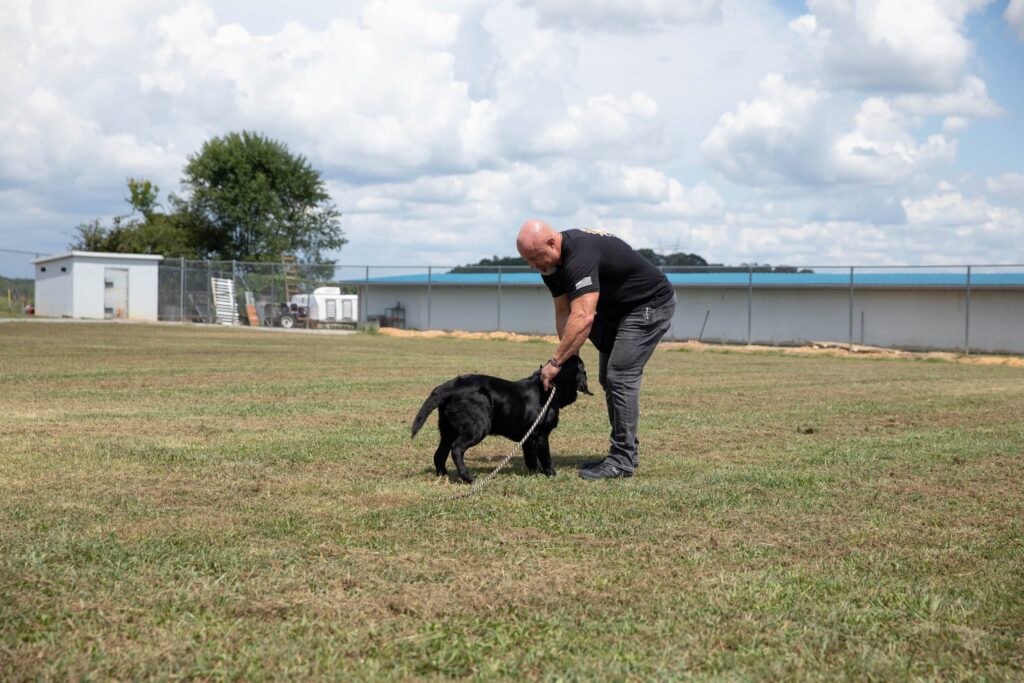Welcome to our post on the question, "Are Labradors easy to train?" If you're considering adding one of these intelligent and loyal dogs to your family, you might be wondering “are Lab Retrievers easy to train and what goes into the process?”
In this blog post and Labrador training guide, we'll explore the breed’s characteristics and provide Lab training tips on how to train a Labrador Retriever successfully. We'll also discuss some common training challenges you may encounter and offer solutions for overcoming them. So, whether you're a first-time dog owner or an experienced trainer, this post is for you!

Are English Labs Easy to Train?
English Labradors are known for their intelligence, eagerness to please, and friendly nature, making them relatively easy to train. Their high level of intelligence means they can quickly grasp new commands and tricks. Labs are typically very food motivated, which can be a significant advantage when using positive reinforcement techniques.
Despite their trainability, Labs can develop bad habits such as chewing and biting if not trained properly. When it comes to how to stop a Labrador puppy from biting, it's essential to address these behaviors early. With dedication and the right approach, Labradors can become obedient, well-behaved companions. Always remember to stay positive and patient, as every dog learns at their own pace.
Importance of Training Them Early On
When searching for Labrador Retriever how-to-train guidance, remember to focus on early socialization and consistent routines to establish good habits. Training a dog at any age is important, but starting early on can have many benefits. For one, it helps establish a strong bond between you and your dog. As you work together to learn new behaviors and commands, you'll be building trust and respect.
Training also helps your dog understand their place in the household, which can reduce the likelihood of behavioral issues down the road. In addition, training your dog early on helps them learn good manners and social skills, which will make them more well-behaved and enjoyable to be around.
It's also easier to teach a puppy new things than an adult dog, as they are more receptive to learning and have shorter attention spans, so it's easier to keep their training sessions short and sweet.
Training your dog early on can help prevent them from developing bad habits or behaviors, such as jumping up on people or begging for food. Overall, the importance of training your Labrador early on cannot be overstated. It will benefit both you and your furry friend in the long run.
Try to remember that no puppy comes into this world knowing what to do: It’s up to you to guide and teach them about their place in this world.
Research shows that early training reaps tons of benefits, such as:
- Improved socialization
- Better communication and development of a more profound bond between the dog and owner
- Alleviating fear and aggression while in a new environment
- Better impulse control
- Increased obedience, as well as instilling good behavior habits, which can help to prevent unwanted behaviors from developing later in their life.
Note: It is essential to understand the importance of socialization. Make sure your pup is exposed to different people, places, and animals. This will help them become comfortable with new situations and better able to deal with change in the future.
So, while it’s essential to train your puppy early on and appropriately, you can be on the right path as long as you start them young and stay consistent. The most crucial learning period of a dog's life is the first six months, as they are most open to learning. Keep in mind that as they get older, they can be harder to train if not already introduced to an established routine.
Male vs. Female Lab: Which is Easier to Train?
There are stark differences between the ways males and females tend to behave in the animal world. Although both male and female Labs are excellent companions, females mature faster than males and may be easier to train. The reason for this is the fact that female Labs have a better attention span and reach puberty as well as their adult weight faster than males do. But, that's not to say that males can't catch on too. They just might require a bit more attention, practice, and patience.
Training Tips

Many professional dog trainers would argue that Labs are almost effortless to work with and can be considered one of the most trainable breeds in the world. It is estimated that the Lab can learn up to 250 words and commands - the average dog can only learn around 165!
Because of this, training a Lab can be a very fun and rewarding experience. There are many different exercises you can do with your pup to help them develop the skills needed for everyday life. Exercises such as obedience training, agility training, scent work, tracking work, and rally obedience are all great ways to keep your Labrador happy and engaged in learning new things.
First and foremost, consistency is key. Make sure that everyone in your household is using the same commands and rewards for your pup. Establish a routine for daily activities such as potty breaks, playtime, meals, walks, etc. This will help your pet understand what’s expected of them and when to expect it.
Next, start teaching your Labrador basic commands. Start with simple ones like “sit” and “stay” and move on to more complex ones as they master the simpler ones. Positive reinforcement is often the best way to teach your pup; use treats or positive verbal praise when they perform a task well. That goes for walking as well. When people ask, “how do you train a Lab puppy to walk on a leash without pulling,” the answer is to use treats and rewards to encourage good behavior during walks.
Want to know how long does it take to train a Lab? It varies, but with consistency, you can see significant progress in a few months. For more Labrador puppy training tips, consider investing in professional training classes.
Use Positive Reinforcement
One of the most effective ways to train and shape your Lab's behavior is by using positive reinforcement, especially when it comes to correcting actions, crate training, and how to potty train a Labrador puppy. Dogs trained using exclusively positive reinforcement methods can have a more secure attachment to their owners and are also less likely to show stress-related behaviors when rewarded positively.
Clicker Training is an effective method of positive reinforcement with the help of a sound: When the Lab performs a wanted behavior, the clicker clicks immediately following the action. This is essentially helpful because it shows the pup the desired behavior you want them to have.
However, the pup needs to be able to associate the clicking sound with a reward. This tactic can sometimes be challenging to try as a new trainer, so many owners opt for puppy training classes where they can receive some guidance.
How Long Does it Take to Train a Labrador Puppy?
It is also important to remember that every pup is different. Some may learn faster than others, while some may take longer. Do not get discouraged if your puppy isn’t picking up the commands as quickly as you would like. Even when they make mistakes, reward them for their effort and remain positive. This will help create a trusting relationship between you and your pet.
It may also help to keep the training sessions short (but frequent). This is because most dogs only have an attention span of about 15 minutes before they get bored, tired, or even begin resisting commands. A good rule of thumb for successful training is to aim for at least 15 minutes every day in five-minute increments. It can also be beneficial to train them in every room of your house so that they can recognize cues in different places and perform commands more efficiently when outside of the home.
Finally, be patient with them. Training can take time, and you may not see results right away. This is because it may take a few weeks to hone your pup's concentration. It is crucial to be consistent and don’t give up; the more effort you put into it, the quicker your pup will learn.
The rewards of training a confident and obedient companion are immeasurable. The bond formed between you and your pup will be one that lasts a lifetime. With the right attitude, patience, consistency, and reward system in place, you can train a Lab who is eager to please and be loyal to their family.
The Benefits of Choosing a Reputable Breeder
Another point to consider when asking are Labrador Retrievers easy to train is that selecting a reputable breeder can significantly increase the likelihood of getting a well-behaved Labrador. Good breeders focus on the health, temperament, and genetics of their dogs, which can result in puppies that inherit traits conducive to training. Puppies from reputable breeders often come from parents who are not only healthy but also demonstrate good behavior and intelligence.
There’s also the fact that some high-quality breeders start training their puppies before selling them. This early training can include basic commands, socialization, and even potty training, making the transition to their new homes smoother. You may be wondering “how long does it take to potty train a Lab?” While it depends on the dog, the answer could be up to six months or more. Investing in a well-bred and partially trained puppy can save time and effort in the long run, providing you with a companion that's easier to train and more adaptable to new environments. A well-bred Labrador is more likely to exhibit a balanced temperament as well, making training sessions more effective and enjoyable.
Last, but not least, many reputable breeders provide support and guidance to new owners, helping them understand the specific needs of their Labrador puppies. This includes offering tips on how to stop Labs from chewing and how do you train a Lab puppy not to bite. Choosing a breeder who is committed to the well-being of their dogs can set the foundation for a successful and rewarding relationship with your new furry friend.
Final Thoughts on How to Train a Labrador Puppy
Labrador retrievers are some of the smartest and easiest dog breeds to train, partly because of their genetics and partly due to the way they are raised. It is mostly up to you and how you decide to go about training them.
After all, the happier and more stimulated your Lab is in their everyday life, the easier they will be to train. So, are Lab Retrievers easy to train? The answer is yes… with the right approaches and plenty of patience! Now that you know how to get started with training, why not give it a go?
Invest some time and effort into teaching your pup basic commands, socializing them, and providing positive reinforcement when necessary. Be sure to research more Lab puppy training tips or pick up a vet-approved Labrador puppy training guide to help make the most out of your how to train a Lab puppy adventure.
If you would like to skip the work of training your puppy, you can purchase one of our puppies and have it professionally trained before your pup even comes home.
